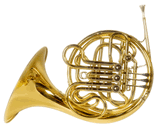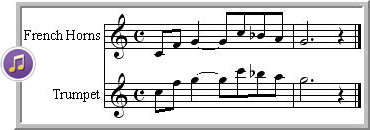 Usage Usage
If you're looking to add sheer macho power to your horn
melody, you can double the four horns
with either one or two trombones.
This brings a gutsy, metallic power to your sound:

In a way, this is not too unlike adding a distortion
effect to a lead guitar sound
to give it more power. The range that works especially well for this effect
is approximately G3 (a below Middle C) to G4 (a above Middle C).
Another way of giving a horn
line more power is to have one or two trumpets
double the melody an octave higher:

This effect is slightly different than the machismo effect
of adding unison trombones. With
the trumpets an octave higher,
there is some breathing room between the horns
and trumpets as you create a fuller,
yet airier quality to the sound.
An interesting phenomenon with the French
horn is the slight delay of the sound. A large part of that delay
is caused by the fact that the French
horns themselves are pointed to the back of the hall. Their sound
does not come straight at you, but rather bounces around the room. To
compensate for this delay, horn
players slightly anticipate the beat. If you are composing a fast brass
line that needs to be played with perfect rhythmic precision, you might
consider writing it for the trumpets
or trombones instead.
To study further usage of the French horns, refer to
the Adventure topic.
|